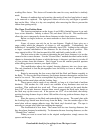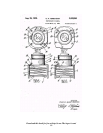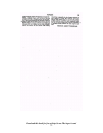Download this book for free at http://www.TheArgusA.com/
65
9 Finding An Argus In Good Shape
The 60 Second Camera Evaluation
You are walking down the street of a city you are visiting and something black,
yet chromed, catches your eye. As you approach it, you see that one of the many antique
stores in this part of the city has just put an Argus A2B in the window, just like the one
you’ve always wanted. You walk in and stare at the lamp next to the camera, so the lady
at the counter doesn’t notice your interest in the Argus. You know that if she sees you
eyeing the camera, its price will skyrocket. To distract her, you approach the counter and
ask if she has any “late 17
th
century Chippendale depression glass of the Prussian style.”
You do not know what these words mean, but you heard them on “Antiques Roadshow”
and they impressed you then. As you so coyly predicted, she claims to have seen some in
the back room and goes to fetch it. You are left with about 60 seconds before the counter
lady returns with a cracked chamber pot. How do you determine whether the A2B is
useable or beyond repair?
The first thing to do is look over the camera to see if there are any obvious flaws.
Are all of the knobs there and do they turn freely? Are the lenses in the viewfinder? Is it
very rusty (minor specks of rust can be cleaned)? Is the body cracked? If its an A2B or
A2F, is the extinction meter there and is the Chart and Slide complete? Is the lens
scratched up? Does the aperture lever and speed adjustment move rather easily? Is there
a lever or button to trigger the shutter? [Certain models (A2Fs and early A2Bs) had a
removable button, and if its broken or not present, you can only fire the shutter with a
cable release.] If any of the above reveal defects in the camera, do not buy it unless you
want it for parts.
Rotate the Head of the camera to expose the Neck. If it is an AF or A2F, rotate
the focus dial. If it moves, even if with difficulty, then it is probably good. Push the
Head into the camera to see if there is any slack in the focus dial mechanism. If there is
any slack, the Neck will not focus properly.
Determine if there is film inside by turning the Rewind Knob. It should turn very
easily if there is no film inside. If it has film, rewind it if you want to try to develop it.
Remove the back cover and inspect the interior. Is there evidence of spilled
chemicals or corrosion on the inside? [The sprocket wheels can be slightly corroded, just
so long as they turn.] Is the inside of the lens area basically clean? Is the door in one
piece, with either a fixed or floating film plate in place?
Now test the film transport mechanism. Run a finger from right to left along the
sprocket wheels so that they turn the way advancing film would turn them. Soon the
sprocket mechanism should stop and lock up. Push the spacing button towards the
viewfinder and hold it there while trying to turn the sprocket wheels. They should now
move freely. Now try to turn the sprocket wheels the other way (finger goes from left to
right). You should be able to spin them and hear an audible click every time the sprocket
wheels go around once. If you can do everything in this paragraph, then the film
transport is functional.
Next you must check the shutter and aperture. Set the shutter speed to its
maximum, either 200 or 150. Look through the lens at a bright light and click the shutter.


















